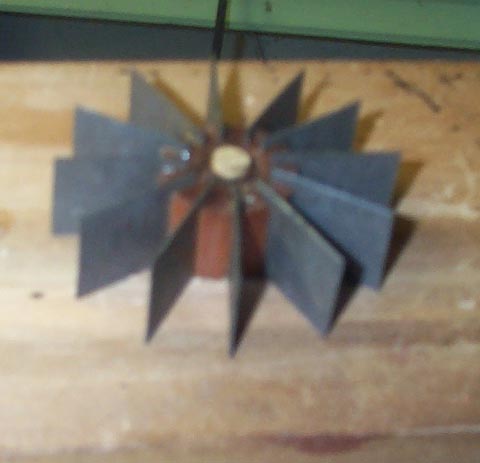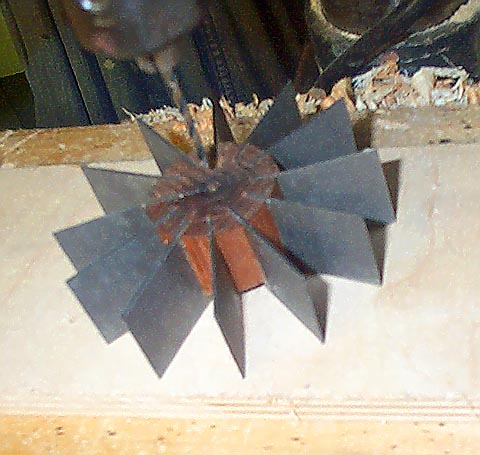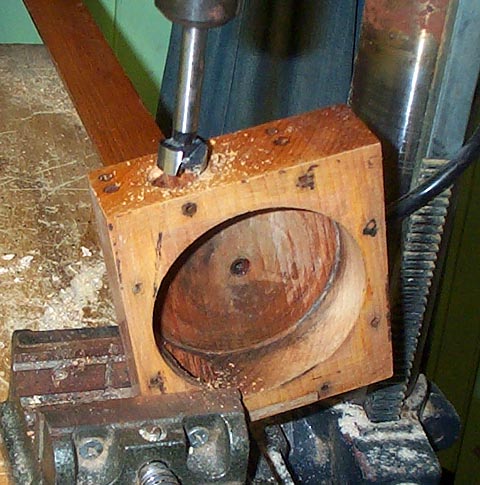
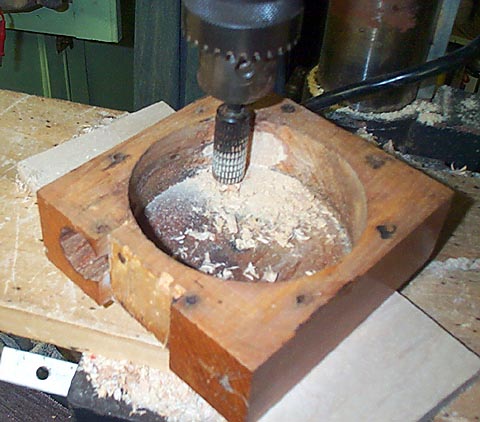
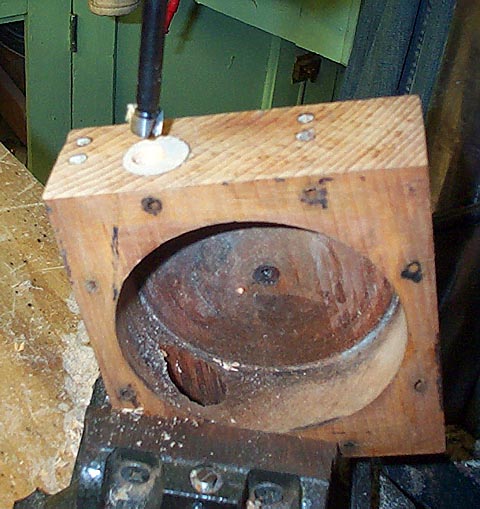
Chapter 23.2 Reworking the Vox Humana Turbine
Someone in the past attempted to make the vox to "work better", presumably to turn easier or faster, by gouging out the wind inlet hole. This betrays a misunderstanding about such a turbine works. This kind of turbine, consisting of a wheel, or hub, with 12 radial cardboard blades, is a true impulse turbine. That is, it works by converting the pressure energy of the incoming air flow to kinetic energy in the velocity of the stream. In other words, the air flow is increased in velocity by passing through a nozzle. According to Barenouli's principal, a fluid can contain potential energy in two forms; pressure, or "kinetic" or motion energy. But that energy can not be changed (except as heat losses, due to friction for example). Therefore, the pressure in the comparatively low velocity flow in the large tube leading to the turbine, can be partly converted to mechanical energy, by passing the flow through a restricted opening. But according to conservation of energy, the pressure at the exit of the restriction, must be proportionally reduced. This transfer of energy is most efficiently achieved by making the restriction tapered; such a tapered restriction is technically called a nozzle.
But an impulse turbine does not have sealed blades; it can not act as a "reverse pump", such as a Dresser-Roots pneumatic motor or gas meter. The pressure in the fluid can have no effect in causing the blades to rotate, since the pressure is necessarily the same on both sides of any blade. Impulse turbines can only be made to turn by having a high velocity stream of fluid strike one side of any blade. Since the blades move more slowly than the velocity of the stream, the stream must suddenly slow down as it hits the blade. Thus the mass flow striking the blade must decelerate, and turned to flow sideways away from the blade surface. Any such deceleration or alteration of direction of any mass, creates a force, at the point of occurrence. An extreme example being the tremendous force on the nail, when the hammer suddenly stops against the nail head. Only kinetic energy in the flowing stream (the energy of its mass-flow rate times its velocity-squared), can create the force on the blades. Pressure at the blades has nothing to do with it.
Summarizing the system stage-wise:
1) In the hose and distribution block at the
top of the turbine, the pressure in the turbine supply is close to the
organ wind pressure. Since the diameter of the hose, and the vox
stop pallet valve seat in the wind chest, is large compared to the nozzle
diameter, the pressure loss due to flow through the system up to this point,
is small. But the velocity of this stream is comparatively modest.
2) The flow passes through a comparatively small
opening (ideally a tapered hole), toward the blade area. Since the
mass flow rate of this air is the same in the feed hose and the nozzle
tip, its velocity must necessarily increase considerably, to get it all
through the small tip opening. But, in order for the flow to accelerate
to this higher velocity, energy is "robbed" from the pressure. Now
the pressure at the nozzle tip is close to atmospheric, but the kinetic
energy in the stream is proportionally increased.
3) The nozzle is aimed tangentially towards the
surface of the turbine blade currently under the nozzle tip. (As one blade
rotates away from the stream, another blade takes its place.)
4) As the flow stream hits the blade, it decelerates
again, and gives up some of its kinetic energy, expressed as "force, times
the (much slower) blade movement", exerted on the blade surface.
This force, always in the same tangential direction, vis a vie the rotation
of the blade array, exerts torque on the blade hub, and turns the vox paddle.
5) The air, now at a lower velocity, escapes
through the exit hole in the bottom of the turbine, to the atmosphere.
Only a small amount of its pressure is needed here; just enough to cause
the air to move through the outlet hole.
Therefore, making the inlet hole larger than the original (apparently about 3/8" in diameter) did no good. In fact it did harm, since there was much less conversion of pressure energy to kinetic energy (the only kind that does any good in the stream). But a lot more total air was wasted in the turbine, to no good effect.
Sorry about the lecture... To fix this situation, I drilled out the old ragged inlet hole; plugged it with new wood; milled the inner end of the plug to the inside diameter of the turbine; and drilled a new 1/4" diameter inlet hole. Then I reamed the hole with a tapered reamer (not shown) to form a nozzle; 5/8" at the inlet, and 3/8" at the inside end.



A new set of turbine blades were made, from 1/32" vulcanized fiber sheet. Some of the old blades, a few of which were still intact, were used as patterns. The array of blades on the hub must be very flat, with each blade parallel to the inner face of the hub. So the hub was clamped to a flat table top, and each blade was glued in with its inner edge against the table surface. Bits of snap-blade were used to wedge the blades into their slots, as the glue dried.
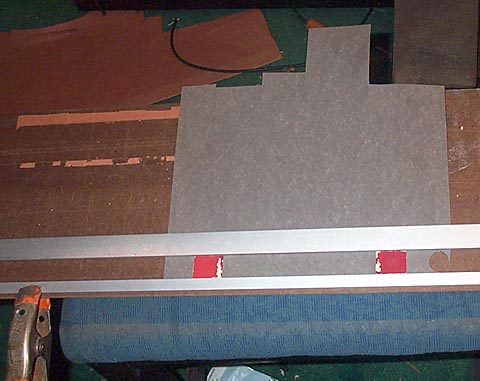


The hole in the center of the hub, where the paddle axle pin is supposed to fit tightly, was found to have been worn oversize on the outer side. I assume that the hub eventually worked loose from the paddle pin, allowing the turbine to spin freely, and wear itself out. It was necessary to drill the worn area out, and plug the hole with new wood. Then a new pinhole was drilled, using the unworn end of the hole as a guide.
